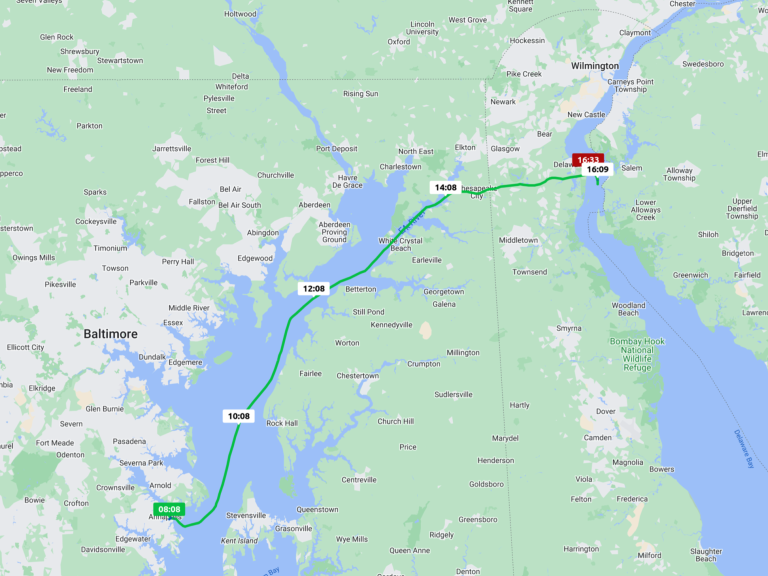
When cruising, one becomes attached to certain places, so there’s always a lump in our throats when it’s time to move on. That, however, is offset by the feeling of excitement for the next leg of the journey, and for discovering new places.
So with those mixed emotions, we left the dock at Annapolis Yacht Basin. The crew of our megayacht neighbor, Tsalta, whom we got to know a little were on deck to wave goodbye.
After exiting Spa Creek, we headed southeast briefly on the Severn River, then turned north to head toward the upper extremity of the Chesapeake Bay.
This route takes us under the Governor William Preston Lane Jr. Memorial Bridge, a.k.a the Baltimore Annapolis Bay Bridge, a.k.a. the Bay Bridge. This 6.5 mile long bridge joins the western and eastern shores of the Chesapeake and is an important artery connecting the Baltimore-Washington metropolitan area with Rehoboth Beach, Delaware and Ocean City, Maryland, two popular beach resorts.
The clearance under the bridge is 186 feet (57 meters), more than twice Fregata’s air draft (height from waterline to top of mast) of 73 feet. But that doesn’t stop the optical illusion from on deck that the mast is going to hit the bridge. After checking multiple charts and data sources to confirm the clearance, we proceeded under the bridge but not without that irrational, subconscious fear that the mast would come crashing down onto the deck.
It would be a short hop to Baltimore, but we chose to skip it given the navigational challenges following the Bay Bridge accident in April. And we’re anxious to get north in search of some relief from the heat.
At the top of the Chesapeake is the Chesapeake & Delaware (C&D) Canal. This 14 mile (23 km) canal was opened in the early 19th century to connect the Chesapeake Bay with the Delware River, offering a much shorter passage between the bay and the ocean. Ben Franklin was one of the promoters of the project. Today, the canal is maintained and managed by the US Army Corps of Engineers and carries 40% of commercial shipping in and out of the busy port of Baltimore.
After an uneventful canal transit, other than a few obnoxious charter fishing boats that seemed to enjoy watching us roll in their wake as they passed too closely and quickly, we exited onto the Delaware River. Although tempted to push on to Cape May, New Jersey, we would arrive close to midnight and we try to avoid entering strange harbors after dark. Also, the tidal currents are strong and we’d be fighting 1.5 knots of flow tide current most of the way. So we decided to anchor outside the shipping channel and move onwards tomorrow morning with the ebbing tidal current pushing us. So here we are, nestled between the industrial smokestacks of Delaware City on one side, and the Salem, New Jersey nuclear power plant on the other. It’s a far cry from the unspoiled beaches, sand dunes and quaint waterfront towns we’ve enjoyed so far, but it’s a necessary passage between the Southeast and New England, where we’re looking forward to more pleasant cruising grounds.
As a side note, Dan’s first ever sailing experience was with his father on the Cooper River, a polluted tributary to the Delaware River, 30 NM north from here in Camden, NJ. Anxious to return there for old times sake? No thanks!!!
Will we fit under?
Crew at Work
There is much work to be done on a cruising sailboat, whether out sailing or moored. One of the tougher crew jobs is that of CFO (chief fender officer). This crewmember is responsible for getting fenders out from storage, inflating them, and hanging them in the appropriate way to protect the boat from damage while at dock. After leaving a dock, she must remove them, deflate them and put them away. Here is Sandy undertaking the grave responsibilities of CFO.